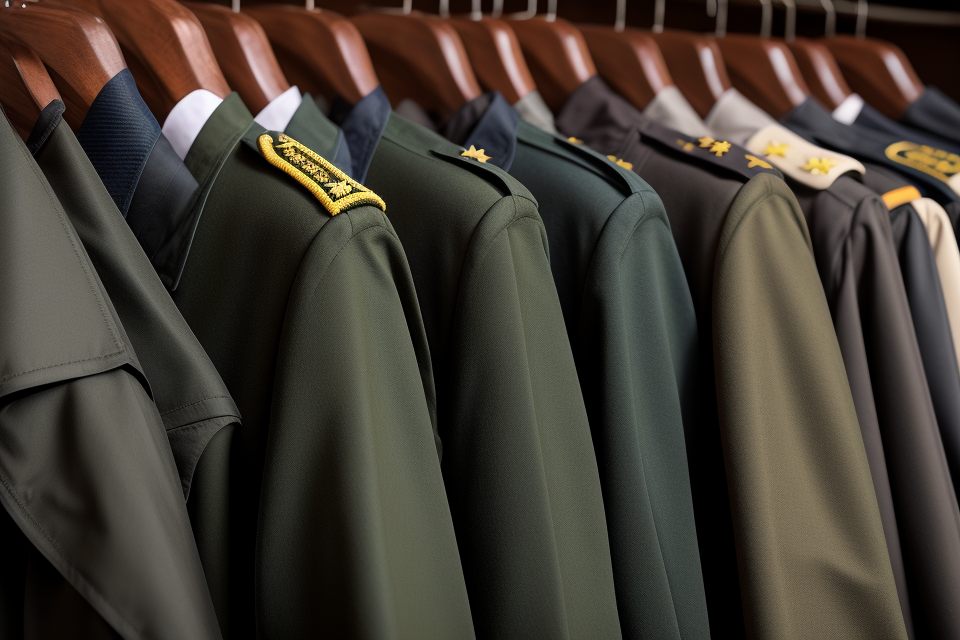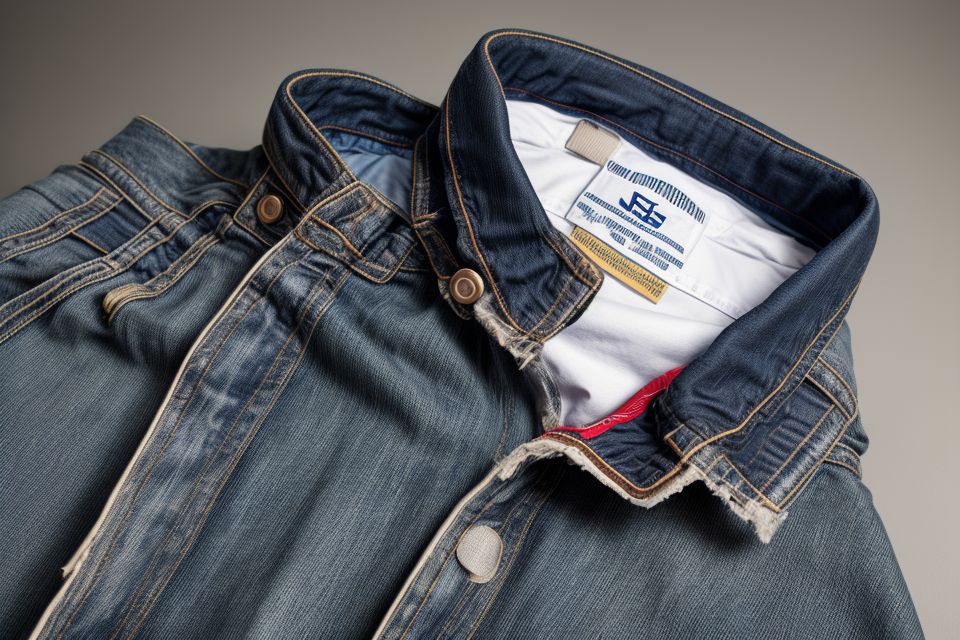
Military uniforms are designed to withstand the wear and tear of rigorous training and combat situations. But just how long do these uniforms last? In this article, we’ll explore the factors that affect the durability and longevity of military uniforms. From the materials used to make them to the demands of the job, we’ll dive into the science behind why some uniforms last longer than others. Whether you’re a soldier, a military enthusiast, or simply curious about the durability of military gear, this article is for you. So, buckle up and get ready to discover the secrets behind the enduring power of military uniforms.
The durability and longevity of military uniforms can vary depending on a number of factors, such as the quality of the materials used, the frequency of wear and laundering, and the level of care and maintenance provided. In general, high-quality military uniforms can last for several years, but this can be influenced by the conditions they are exposed to, such as exposure to water, dirt, and sunlight. The type of uniform and its intended use can also impact its lifespan, with combat uniforms designed for use in harsh environments typically being more durable than dress uniforms worn for ceremonial events. Proper care and maintenance, including regular cleaning and inspection, can help to extend the lifespan of military uniforms and ensure they remain in good condition for as long as possible.
Factors Affecting the Durability of Military Uniforms
Material and Construction
Uniform Type
The type of military uniform plays a crucial role in determining its durability. Different uniforms are designed for specific purposes and conditions, and thus, the materials and construction methods used can vary significantly. For instance, a combat uniform designed for ground operations may require a more robust and durable material compared to a ceremonial uniform designed for parades and formal events.
Fabric Composition
The fabric composition of a military uniform is another essential factor that affects its durability. Uniforms made from cotton or cotton-blend fabrics are generally less durable than those made from synthetic materials like polyester or nylon. Synthetic materials are more resistant to water, tearing, and fading, making them ideal for military uniforms that need to withstand harsh environments and frequent wear.
Stitching and Reinforcement
The stitching and reinforcement methods used in the construction of military uniforms can also impact their durability. Uniforms with reinforced seams, such as those found in the shoulders and knees, are more likely to withstand wear and tear caused by frequent movement and activities. Additionally, uniforms with double stitching or reinforced stress points, such as the sleeve cuffs and collar, are less prone to tearing and fraying. The quality of the stitching and reinforcement also plays a significant role in determining the longevity of the uniform. Poorly stitched or reinforced uniforms are more likely to fail or deteriorate faster than those with high-quality workmanship.
Care and Maintenance
Cleaning and Laundry
Proper cleaning and laundry techniques play a significant role in determining the longevity of military uniforms. Dirt, grime, and stains can wear down the fabric and compromise the uniform’s integrity, while improper cleaning methods can damage the material or cause color fading.
Storage and Packing
The way military uniforms are stored and packed can also affect their durability. Improper storage can cause wrinkles, creases, and other forms of damage to the uniform, while inadequate packaging can expose the uniform to potential hazards such as moisture, dust, or dirt.
Repairs and Alterations
Repairs and alterations are often necessary to maintain the quality and functionality of military uniforms. Timely repairs can prevent further damage to the uniform, while alterations can ensure a proper fit and improve the overall comfort and wearability of the uniform.
In summary, care and maintenance are crucial factors that affect the durability and longevity of military uniforms. Proper cleaning and laundry, effective storage and packing, and timely repairs and alterations can significantly extend the lifespan of military uniforms and ensure they remain in optimal condition for the wearer.
Operational and Environmental Conditions
The operational and environmental conditions in which military uniforms are used play a significant role in determining their durability and longevity. Some of the key factors that affect the lifespan of military uniforms in these conditions include:
- Temperature and Humidity: The temperature and humidity levels at which military uniforms are worn can have a significant impact on their durability. For example, uniforms that are exposed to high temperatures and humidity levels for extended periods of time may be prone to damage from sweat and moisture. In addition, uniforms that are worn in extremely cold temperatures may become stiff and less flexible, which can lead to tearing or ripping.
- Exposure to Elements: Military uniforms are often exposed to various elements such as sunlight, wind, and rain, which can cause wear and tear over time. For example, uniforms that are exposed to strong sunlight for extended periods of time may fade or become discolored. In addition, uniforms that are exposed to rain or other forms of moisture may become heavy and uncomfortable to wear, which can lead to damage or tearing.
- Physical Activity and Injury: Military personnel are often required to engage in physically demanding activities, which can put their uniforms at risk of damage or tearing. In addition, injuries sustained during physical activity can also cause damage to military uniforms. For example, a uniform that is caught on a sharp object or rough surface may become torn or damaged.
Types of Military Uniforms and Their Durability
Battle Dress Uniform (BDU)
The Battle Dress Uniform (BDU) is a type of military uniform that was widely used by the United States military from the 1980s until the mid-2000s. It was designed to be a durable and functional uniform for combat situations, and it was made from a combination of cotton and nylon materials.
Features and Durability
The BDU was designed to be a versatile and durable uniform that could withstand the rigors of combat. It featured a camouflage pattern that was designed to help soldiers blend in with their surroundings, as well as a number of pockets and other features that were intended to make it easy for soldiers to carry their gear.
One of the key features of the BDU was its durability. The cotton and nylon materials that it was made from were resistant to wear and tear, and the uniform was designed to be able to withstand the rough handling that it would inevitably receive in combat situations. In addition, the BDU was designed to be comfortable to wear, with a loose fit that allowed soldiers to move freely and easily.
Common Issues and Repairs
Despite its durability, the BDU was not without its issues. One common problem was that the camouflage pattern could fade or wear off over time, which could make it less effective at helping soldiers blend in with their surroundings. In addition, the pockets and other features of the BDU could become worn or damaged over time, which could make it difficult for soldiers to carry their gear.
Repairs to the BDU were typically carried out by military personnel or by civilian contractors who specialized in military clothing and equipment. Common repairs included replacing worn or damaged pockets, patching holes or tears in the fabric, and replacing worn or damaged buttons or other hardware. In some cases, it may have been necessary to replace the entire uniform if it had become too worn or damaged to be repaired.
Combat Uniform
A combat uniform is designed to be durable and functional, providing military personnel with the necessary protection and mobility during operations. These uniforms are typically made from materials such as nylon, cotton, and polyester, with some featuring reinforced knees, elbows, and other high-stress areas. The combat uniform’s durability is also enhanced by its construction, with double-stitched seams and reinforced buttons.
Despite their durability, combat uniforms can still experience wear and tear over time. Common issues include fading, tearing, and ripping, especially around the shoulders and seams. To prolong the life of the uniform, regular maintenance is essential. This includes washing and drying the uniform according to the manufacturer’s instructions, as well as conducting inspections for signs of wear and tear. Small tears can often be repaired with fabric patches or duct tape, while more significant damage may require a professional repair. In some cases, the uniform may need to be replaced entirely if it has become too damaged to be repaired.
Marine Corps Dress Uniform
The Marine Corps Dress Uniform, also known as the Blue Dress Uniform, is a ceremonial uniform worn by Marines for formal occasions. This uniform consists of a blue coat with gold buttons, a white shirt, a blue tie, and a pair of blue trousers. The women’s version of the uniform includes a blue evening dress or a blue trousers and coat ensemble.
The fabric used for the Marine Corps Dress Uniform is made of a wool and polyester blend, which makes it durable and long-lasting. The coat and trousers are designed to be tailored to fit each individual Marine, ensuring a snug and comfortable fit. The uniform is also designed to be easy to maintain, with detachable components that can be dry-cleaned or hand-washed.
The Marine Corps Dress Uniform is designed to be a symbol of pride and honor for Marines, and it is intended to be worn for special occasions such as change of command ceremonies, military balls, and other formal events. As such, it is important that the uniform remains in good condition and is properly cared for.
While the Marine Corps Dress Uniform is designed to be durable and long-lasting, there are certain issues that may arise over time. One common issue is the wear and tear on the buttons, which may become loose or fall off over time. This can be fixed by a professional tailor or by the Marine themselves using button replacement kits.
Another common issue is the yellowing of the fabric, which can occur over time due to exposure to light and air. This can be prevented by storing the uniform in a cool, dry place and avoiding exposure to direct sunlight. If the yellowing is already present, it can be removed by a professional dry cleaner.
Other issues that may arise include tears, stains, and fading. These can be fixed by a professional tailor or by the Marine themselves using stain removal products and careful cleaning. It is important to ensure that the uniform is properly cared for to maintain its longevity and to keep it in good condition for future use.
Extending the Life of Military Uniforms
Proper Care and Maintenance
Maintaining military uniforms in good condition is essential to prolong their lifespan. Here are some guidelines for proper care and maintenance:
Cleaning and Inspection
Regular cleaning and inspection of military uniforms are crucial to ensure they remain in good condition. Dirt, sweat, and other contaminants can cause damage to the fabric and compromise the uniform’s functionality.
Military uniforms should be washed with mild detergent and cold water to prevent shrinkage and damage to the fabric. The uniform should be washed separately from other clothes, and any badges, patches, or rank insignia should be removed before washing.
After washing, the uniform should be inspected for any damage or wear and tear. Any damaged areas should be repaired or replaced promptly to maintain the uniform’s functionality and appearance.
Proper storage and packing of military uniforms can help preserve their condition and extend their lifespan. Uniforms should be stored in a cool, dry place, away from direct sunlight and moisture.
When packing the uniform, it should be placed in a clean, breathable bag or container to prevent damage to the fabric and prevent the buildup of odors. The uniform should be hung or folded properly to prevent creasing or wrinkling.
Repairs and alterations are necessary to maintain the uniform’s functionality and appearance. Any damaged or worn-out parts should be repaired or replaced promptly to prevent further damage.
Small repairs, such as sewing on a missing button or patch, can be done by the wearer. However, more significant repairs, such as replacing a damaged rank insignia or repairing a hole in the fabric, should be done by a professional.
Alterations, such as adjusting the size or length of the uniform, can also be done by a professional. This ensures that the uniform fits correctly and provides the necessary functionality and protection.
In summary, proper care and maintenance are crucial to extending the life of military uniforms. Regular cleaning, inspection, storage, and packing, as well as prompt repairs and alterations, can help preserve the uniform’s condition and functionality.
Budgeting for Replacement
-
Replacement Timeline
- Factors such as wear and tear, frequency of use, and storage conditions can all impact the lifespan of military uniforms. As a result, it’s important to establish a replacement timeline that takes these factors into account.
- This timeline will vary depending on the type of uniform and its intended use. For example, a combat uniform that is used daily in harsh environments may need to be replaced more frequently than a ceremonial uniform that is only worn a few times a year.
- To determine the appropriate replacement timeline, it’s important to conduct regular inspections of the uniforms and assess their condition. This can help identify any signs of wear and tear, such as fading, staining, or tearing, that may indicate the need for replacement.
-
Factors Affecting Replacement
- In addition to wear and tear, there are several other factors that can impact the longevity of military uniforms. These include:
- Environmental conditions: Uniforms that are exposed to extreme temperatures, moisture, or UV rays may deteriorate more quickly than those that are stored in more favorable conditions.
- Maintenance: Regular cleaning and maintenance can help extend the life of military uniforms. However, poor maintenance practices, such as using the wrong type of cleaning solution or storing uniforms improperly, can cause damage and reduce their lifespan.
- Individual factors: Factors such as body size, activity level, and personal hygiene can also impact the longevity of military uniforms. For example, uniforms that are too small or too large may not fit properly, which can cause discomfort and increase the risk of damage.
- In addition to wear and tear, there are several other factors that can impact the longevity of military uniforms. These include:
-
Making the Most of Your Budget
- When budgeting for the replacement of military uniforms, it’s important to consider both the cost of the new uniforms and the cost of maintaining and repairing the existing uniforms.
- To make the most of your budget, consider the following strategies:
- Prioritize the replacement of uniforms that are most essential to the mission or most frequently used.
- Invest in high-quality uniforms that are designed to last longer and withstand more wear and tear.
- Implement regular maintenance and cleaning practices to extend the life of the uniforms and reduce the need for frequent replacements.
- Consider purchasing uniforms in bulk or negotiating bulk discounts with suppliers to save on costs.
FAQs
1. How long do military uniforms last?
Military uniforms are designed to be durable and long-lasting, and the lifespan of a uniform can vary depending on factors such as the material, quality of construction, and level of care. In general, a military uniform can last anywhere from a few months to several years, depending on the conditions it is exposed to and the level of wear and tear.
2. What factors affect the durability of military uniforms?
There are several factors that can affect the durability of military uniforms, including the type of material used, the quality of construction, and the level of care the uniform receives. Uniforms made from high-quality materials and constructed with attention to detail are more likely to last longer than those made from lower quality materials or constructed poorly. Additionally, proper care and maintenance, such as cleaning and mending, can help extend the lifespan of a military uniform.
3. How often should military uniforms be replaced?
The frequency with which military uniforms should be replaced can vary depending on the specific circumstances and the level of wear and tear. In general, a military uniform should be replaced when it becomes damaged or worn beyond repair, or when it no longer meets the required standards for wear. This can range from a few months to several years, depending on the conditions the uniform is exposed to and the level of care it receives.
4. Can military uniforms be repaired?
Yes, military uniforms can often be repaired if they become damaged or worn beyond repair. Repairs may include mending tears, replacing buttons or other hardware, or sewing on new patches or insignia. The ability to repair a military uniform will depend on the extent of the damage and the availability of replacement parts or materials.
5. Are there any special considerations for caring for military uniforms?
Yes, there are several special considerations that should be taken into account when caring for military uniforms. Uniforms should be cleaned and pressed regularly to maintain their appearance and prevent damage from dirt and stains. Additionally, certain types of uniforms may require special care, such as protective gear or uniforms made from synthetic materials. It is important to follow the specific care instructions provided with each uniform to ensure it is properly maintained and lasts as long as possible.


